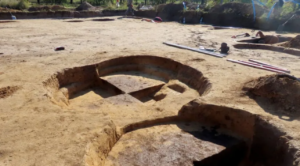Recent excavations in Sandomierz-Mokoszyn, located in Poland’s Świętokrzyskie region, have unveiled one of the earliest examples of a Neolithic “long house” on the Sandomierz Upland, dating back to between 5300 and 4900 BCE.
The excavation project, conducted by the Three Ages studio from Klimontów, was originally launched to confirm the presence of a Funnel Beaker culture settlement (3700-3200 BCE). This culture, known for large storage pits, pottery fragments, flint tools, stone querns, and animal bones, was already evidenced in the area. However, archaeologists also found an earlier Neolithic settlement from the Linear Pottery culture, associated with the first farmers who migrated to this region from Transcarpathia.

Ph: M. Bajka, Voivodeship Department of Monument Protection in Kielce
The Linear Pottery culture, one of the earliest Neolithic cultures in Central and Eastern Europe, thrived from approximately 5500 to 4500 BCE. Its name is derived from the distinctive linear patterns found on ceramic vessels, often filled with white paste.
The team found traces of a “long house”, constructed using a post-and-beam technique and aligned along a north-south axis. Similar structures have been previously identified in regions like Kujawy, Subcarpathia, and Lesser Poland, but this is the first instance in this area. Dr. Marek Florek, a representative of the Sandomierz delegation of the Provincial Office for Monument Protection, said, “The discovery of the longhouse is the first of its kind in the Sandomierz Upland. It indicates a permanent settlement in the early Neolithic period, rather than a temporary encampment.”
The team also unearthed evidence of continuous habitation in the area over thousands of years. Surrounding the long house, they discovered various utility pits, including clay pits from which material was sourced for building walls. Among the artifacts found were decorated ceramics, flint tools, and two pits containing objects made of obsidian, a volcanic glass imported from what is now Slovakia or Hungary.
According to Dr. Florek, “This is an interesting discovery, which confirms the continuity of settlement in this area over several thousand years.” He further noted that all the discovered artifacts will undergo scientific study before being transferred to the Sandomierz Castle Museum for preservation.
Source:
Nauka w Polsce


